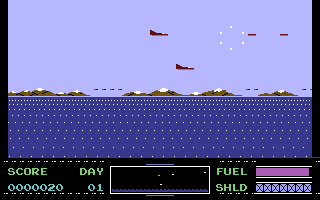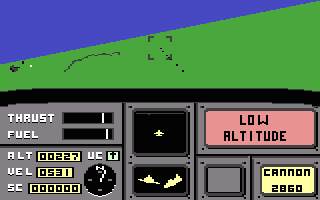By: Commodore
Release Date: 1984
Discontinued a year after it was released, nicknamed the Minus/60 in America and not really designed for gaming at all, you might think that the Commodore Plus/4 makes for a pretty uninspiring console. After all, it included word processing and spreadsheet software, and had no sprite capability for video games. It was intended as a replacement for the Commodore 64, however being almost completely incompatible with most peripherals and software for the system, it represented a significant financial investment. While the price was lowered to near-ridiculous levels at the end of its production, there was no doubt that it never really took off as a home computer or video games console.
In terms of its technical specifications, it surpasses the Commodore 64 with a faster processing speed, more ROM and RAM available to programs and more colours. The only areas it seems to be lacking in is sound and sprite capability, which obviously are rather useful when it comes to video games. The real problem for the Commodore Plus/4, however was that it was released alongside the Commodore 16, which was essentially a less powerful version of the Plus/4. While the Commodore 16 games were compatible with the Plus/4, most games produced were intended for the power of the Commodore 16, since it was the cheapest option of the new models available.
As the Plus/4 didn't get a whole lot of dedicated games, it missed out on titles which used its superior processing power. As a result, most of the Plus/4 game library is made up of Commodore 16 games which are compatible with it and the few games that were made specifically for the console suffer from its lack of specialization in gaming specs. After all this, you might wonder why I'd want to play or even own what is essentially a home computer that can play a few games designed for a lesser home computer, but I think games on these systems show an important step in gaming between Atari's 2600 games and the arrival of the NES.
 |
| (Bandits at Zero - 1987) |
The datasette module which comes with the Plus/4 is used to load the data from the cassettes into the memory of the console. Aside from the slow load times and outdated nature of cassette tapes as a whole, it's not the worst way to store games although obviously there are risks such as contact with magnets which come into play with tapes. To save high scores players had to insert their own high score tape in to the machine when prompted and then record data onto it.
| (Games on a tape? I couldn't believe it at first either) |
The Commodore Plus/4 games that I own play mostly like arcade games with lives and simple goals to complete for each level, bu there were also text adventures and flight simulators released for the console. With a keyboard and/or joystick to control gameplay there were various control options for games, especially with the keyboard. As the joystick only features one button it's comparable to the Atari 2600 joystick although I personally prefer the movement of the Plus/4 one. As such most games with joystick control feature a single action for the button and movement with the joystick.
While the graphics are basic for most if not all original releases on the Plus/4, it has been proven in recent years that the system was capable of so much more in the right hands. Obviously the game developers at the time had no concept of the sort of graphics we see on today's systems, but with an continued underground popularity combined with the recent surge of interest in retro gaming, there continue to be games released for the system in some form. Making better use of the processing power and limited graphical capabilities, the more recent games for the Plus/4 would have blown minds back in 1985.
Counting games released for the Commodore 16 as Plus/4 releases, the best games of the time seem to be well executed arcade conversions or something that gives a clever edge to the usually basic and uninspiring games of the console. The best Plus/4 game I've played so far for the console, Ace: Combat Simulator had so many elements which were ahead of its time, that it stood out from the rest of the titles I had played as being more substantial both in gameplay and as a whole. My current top 10 for the console looks like this:
While the graphics are basic for most if not all original releases on the Plus/4, it has been proven in recent years that the system was capable of so much more in the right hands. Obviously the game developers at the time had no concept of the sort of graphics we see on today's systems, but with an continued underground popularity combined with the recent surge of interest in retro gaming, there continue to be games released for the system in some form. Making better use of the processing power and limited graphical capabilities, the more recent games for the Plus/4 would have blown minds back in 1985.
 |
| (Sabrewolf - 2012) |
| 1. | Ace: Combat Simulator |
| 2. | Exorcist |
| 3. | Spectipede |
| 4. | Petals of Doom |
| 5. | Spore |
| 6. | Treasure Island |
| 7. | Icicle Works |
| 8. | Space Sweep + Invaders |
| 9. | Fire Ant |
| 10. | Magician's Curse |
All of these games displayed some sort of element that reminded me of a later game which had built upon it. There were good ideas and execution before there was really the console power to pull them off. I do intend to get more Plus/4 titles, both emulating and buying so this may be updated as I go along.
 |
| (ACE Combat Simulator - 64kb version) |
On the whole, the Plus/4 isn't really as bad of a console as it may appear. Whilst most of its game library is simplified so as to also play on the Commodore 16, there are some truly interesting titles to be experienced as well as a sample of the worst that the gaming world had to offer at the time also. It's important to remember that the video game crash of 1983 was still having an effect on the market until at least 1987 when the NES restored faith in the industry. The generally low scores that the games for the system have received on this blog are a product of their simple nature and attempting to compare the increased complexity and programming of modern games.
For a console not really intended to be used for gaming, without sprite capability, I'd say that the Commodore Plus/4 does pretty well. Hopefully I'll be able to check out more modern games that people have developed for it too in the near future.


No comments:
Post a Comment